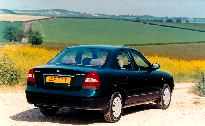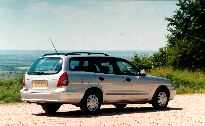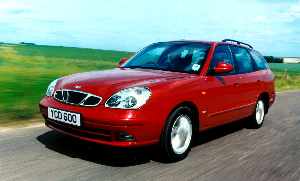
|
|
|
Interior |

|
|
The interior redesign has also resulted in greater space. The interior length has been increased by 8mm overall, while there's an overall increase in interior width of 30mm. Comfort has also been significantly enhanced thanks to new seats with longer cushions, reshaped bolsters and greater lateral support. The driver's seat now has individual front and rear height adjustment while both front seats feature lumbar adjustment. Front head restraints are now tilt-adjustable, while there are height-adjustable head restraints in the rear and, in the CDX, a centre rear arm rest as well. Other new safety considerations include the fitment of three point safety belts for all three seats in the rear of the saloon. New fabrics, higher quality carpets, chrome interior door handles and, for the CDX, a metallic finish for the facia, all combine to give the new Nubira a more refined, sophisticated feel. Refinement is improved, too. A fourth engine mounting point reduces the transmission of noise and vibration to the interior, while three layers of insulating material under the carpets and bonnet and no fewer than six layers of insulation between the engine and interior, combine to make the Nubira quieter than ever.
Engines and Transmissions The most significant aspect of this engine, however, is the variable geometry induction system (VGIS) which is designed to maintain good levels of torque at low engine speeds thanks to the long inlet manifold tract. At higher speeds, a control valve in the manifold is opened, shortening the route taken for air to reach the combustion chamber, giving a 10 per cent increase in torque. The 2.0-litre unit also features four valves per cylinder and a twin cam head with centrally mounted spark plugs. It develops 133bhp and 123lb.ft of torque to give the Nubira CDX saloon a top speed of 121mph with the 0-60 mph time cut to 9.0 seconds. Both engines feature exhaust gas recirculation which reduces the volume of fuel/air mixture into the combustion chamber to produce a more complete burn. This helps improve economy and reduces the production of NOx emissions. They also now feature a 16-bit processor, upgraded from the previous 8-bit version. The new processor gives more precise control of the engine combustion cycle which, in turn, helps promote better fuel economy. On average, the new Nubira is 5 per cent more fuel efficient than the old model, the SE saloon returning 36.2 mpg, and the CDX saloon returning 32.8 mpg over the EU combined cycle. Mounted transversely, the engines drive the front wheels through a standard five-speed manual gearbox coupled to a single dry plate clutch. The gearbox is Daewoo-developed, with a one-piece casting strengthened to allow for the higher outputs of the new engines. A new four speed electronically controlled automatic transmission is available as an option on 2.0-litre models. This transmission, developed for Daewoo by ZF, is a state-of-the-art two mode (power and economy) automatic, with torque converter lock up in fourth. This is its second appearance in a Daewoo - it is also used in the Daewoo Leganza. |
|

|
Chassis, Steering & Brakes |
|
The Nubira's rack-and-pinion steering has been upgraded for the new model, with a revised power steering pump delivering higher degrees of assistance at low speeds. As speeds rise, the level of assistance is gradually reduced to provide greater steering feel. Braking has also been upgraded for the new model with the adoption of a state-of-the-art Bosch four-channel ABS system featuring electronic brake force distribution (EBD). The new Bosch system gives improved stopping distances while the EBD automatically senses vehicle loading, road surface condition and cornering angles to distribute the braking power to the wheel or wheels with the greatest grip. As before, all Nubiras feature ventilated discs at the front with drum brakes at the rear on SE models and solid disc brakes at the rear on the CDX. The Nubira SE saloon and estate models have 14-inch steel wheels with full trim covers and are shod with 185/65 R14 tyres. New for 1999, the CDX has 15-inch steel wheels with 195/55 R15 tyres as standard.
Warranty |
|

| [Contents] [Home] [News] [Features] [Car of the Week] [Motorsport] [A-Z] |


